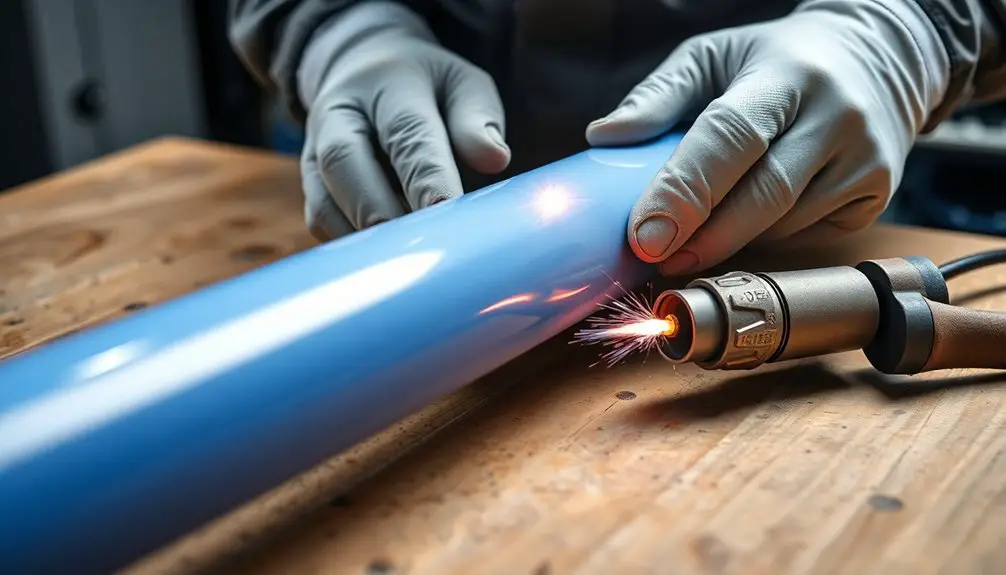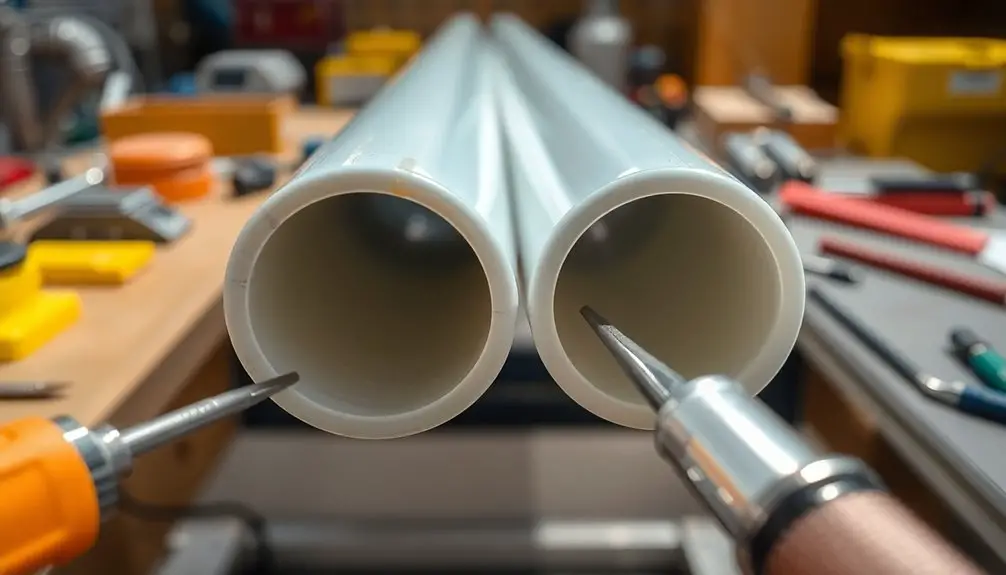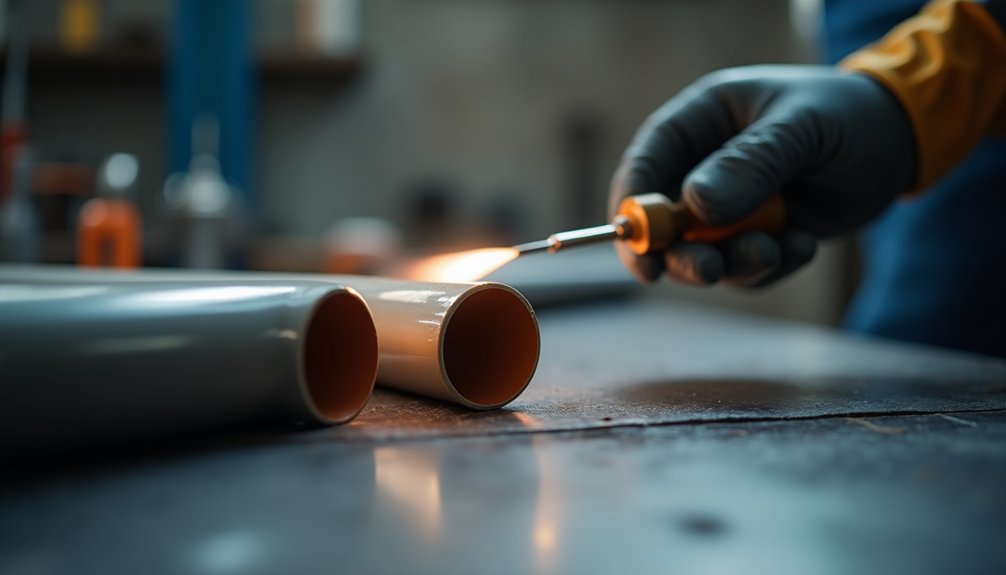To join polypropylene pipes and parts, you'll primarily use heat fusion, which ensures a strong, leak-proof bond. First, trim the pipes cleanly and bevel the ends for better alignment. Clean the surfaces to eliminate debris, and then use a fusion tool to heat the pipe and fitting ends to about 260 °C (500 °F). Align them straight and hold them together for at least 30 seconds. After removing from the tool, let the joint cool completely for optimal strength. Inspect for any faults to ensure durability. If you're curious about more tips and techniques, there's plenty more to explore.
Key Takeaways
- Ensure proper preparation by trimming, cleaning, and beveling pipe ends before fusion for effective joining.
- Utilize a fusion tool to heat pipe and fitting ends to approximately 260 °C (500 °F) for a secure bond.
- Align the pipe and fitting straight to prevent twisting during the joining process, ensuring a leak-proof connection.
- Hold the fused pieces together for at least 30 seconds and allow 10-15 minutes for cooling before applying stress.
- Inspect the joint for gaps or misalignments post-cooling and conduct a pressure test to verify integrity.
Overview of Polypropylene Pipes
Polypropylene pipes, particularly polypropylene random copolymer (PPR), are increasingly popular in plumbing due to their exceptional durability and resistance to corrosion. You'll find PPR pipes ideal for both hot and cold water applications, as they can handle high temperatures without degrading. When working with these pipes, you'll appreciate their flexibility in size, with diameters typically ranging from 16 mm to 110 mm, allowing you to insert the pipe seamlessly into various plumbing configurations. One of the standout features of PPR pipes is their joining method. Unlike traditional PVC, which relies on cement, PPR pipes are typically joined using a heat fusion method. This process involves heating the pipe and fitting to a temperature of 260 °C (500 °F) before you insert the pipe and join them, creating a leak-proof bond once cooled. This strong connection is crucial for ensuring the longevity and reliability of your plumbing system. Additionally, if you're using PPR for hot water, consider insulation to maintain temperature efficiency. This small step can prevent heat loss and enhance the overall performance of your piping system. PPR pipes are also beneficial for the environment since they have lower lifecycle emissions compared to some alternative materials.
Required Tools and Safety Measures
When working with polypropylene pipes, having the right tools and safety measures in place is vital for a successful installation. You'll need PPR fusion tools, which come in handheld and bench-mounted models, typically priced between $50 and over $500 depending on size and type.
Before you begin, ensure the fusion tool is heated correctly and that you've selected the right socket size for your pipe and fitting.
To maximize safety and efficiency, remember these essentials:
- Heat-resistant gloves to protect your hands
- Long sleeves to shield your arms from burns
- A secure hairstyle to keep hair away from high temperatures
Cleaning is also crucial—wipe down the exterior of the pipe and the interior of the fitting with a dry rag to eliminate debris.
A silicone spray on heater faces can enhance performance. Lastly, always adhere to the manufacturer's guidelines for insertion depth and timing to ensure a secure, leak-proof joint.
Preparing the Pipe for Fusion

Before you start the fusion process, it's crucial to prepare the pipe properly. Begin by trimming the polypropylene pipe to the desired length. Make sure to use a clean, smooth cut; this ensures proper fusion later on.
Next, you'll want to clean the exterior of the pipe and the interior of the fitting with a dry rag. This step is important, as any contaminants can negatively affect the fusion process.
After cleaning, bevel the outside diameter of the pipe end. This will facilitate better fusion and alignment when you join the pieces. To ensure a secure bond, use a depth gauge to mark the insertion depth on the pipe. This will help you accurately insert the pipe into the fitting.
Finally, if you need to stabilize the handheld fusion tool, consider using a vise or getting assistance. This will help you maintain control and precision as you prepare for the fusion.
Fusion Process for Joining
The fusion process for joining polypropylene pipes is a critical step that requires careful attention to detail. First, you'll need to heat the ends of the pipe and fitting using a fusion tool until they reach approximately 260 °C (500 °F). Make sure you align them correctly right before inserting them together.
Here are some key points to keep in mind:
- Ensure the pipe and fitting are straight when joining them, avoiding any twisting or angling.
- Hold the fused pieces together for at least 30 seconds after removing them from the fusion tool.
- Double-check for proper alignment during the cooling process to maintain the joint's integrity.
Once you've completed these steps, allow the joint to cool completely. This ensures a strong bond and a secure, leak-proof connection.
Post-Fusion Inspection and Tips

Post-fusion inspection is essential to ensure a secure and reliable connection in polypropylene pipe systems. After the fusion process, take the time to carefully inspect the joint for any irregularities like gaps, misalignments, or discoloration, which could indicate a faulty connection.
Ensure the fused joint is properly aligned and seated without any twisting or angling; incorrect alignment can easily compromise the integrity of the bond.
Before applying any pressure or stress, allow the fused joint to cool completely for about 10-15 minutes. This cooling period is crucial to prevent joint failure. During this time, document the installation details, including the date, temperature settings, and any observations about the fusion process. This record will be invaluable for future reference and troubleshooting.
Once the joint has cooled completely, conduct a pressure test to verify its integrity. This test will help ensure there are no leaks in the system, confirming that your fusion process was successful.
Frequently Asked Questions
How to Join Polypropylene Pipes?
To join polypropylene pipes, you'll need to use heat fusion. Cut and bevel the ends, then heat them to 260 °C. Press them together for 30 seconds, ensuring alignment for a strong bond.
How Do You Connect Two Pieces of Poly Pipe?
To connect two pieces of poly pipe, you'll heat the ends until they reach about 260 °C, press them together for a secure bond, and hold them aligned for 30 seconds to ensure proper fusion.
What Is the Normal Method of Joining Polyethylene Pipe?
When joining polyethylene pipe, you typically use heat fusion, like butt fusion or electrofusion, or mechanical fittings. Proper alignment and surface preparation are essential to ensure a strong, leak-proof connection that lasts.
Do You Glue Polypropylene Pipes?
You can't glue polypropylene pipes. Their chemical properties prevent traditional adhesives from bonding effectively. Instead, you should use socket heat fusion, which creates a strong, leak-proof joint by melting the pipe ends together.

